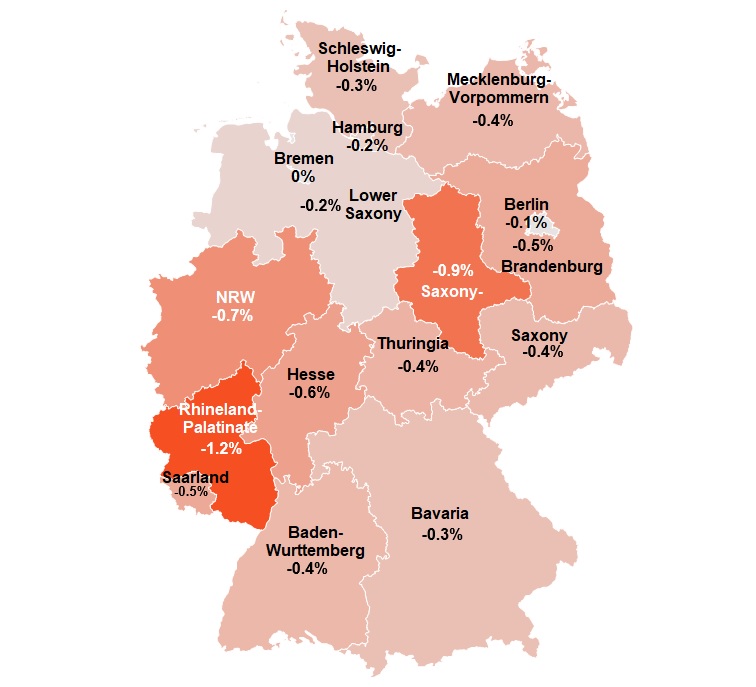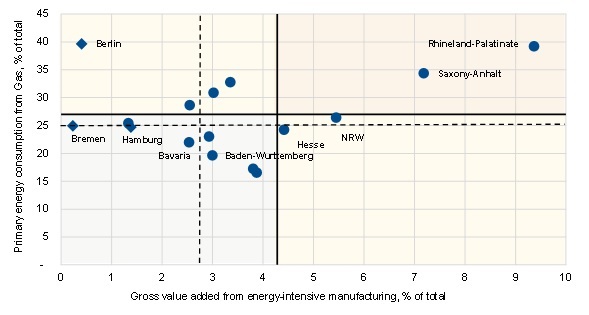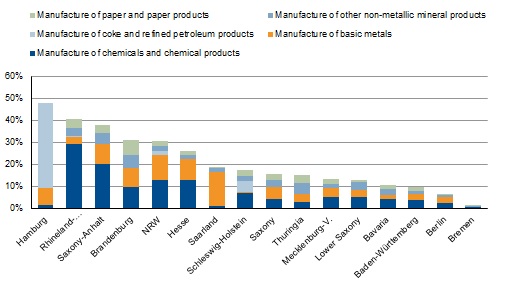Announcements
Drinks

German Länder: energy shock concentrated in two states; federal budget cushions blow
 By Julian Zimmermann, Senior Analyst, Sovereign and Public Sector
By Julian Zimmermann, Senior Analyst, Sovereign and Public Sector
The energy crisis, aggravated by Russia’s weaponisation of its energy exports, is harshly affecting Germany’s industry and the national economy. We forecast German real GDP growth at just 1.4% this year before a decline of 0.2% in 2023.
Among the most affected sectors is energy-intensive industry, which is concentrated in specific parts of the country, explaining why economic losses are unevenly distributed across the 16 Länder (Figure 1).
We estimate cumulative losses of output at 1.2% and 0.9% of GDP in the period 2022-23 respectively in the two most exposed Länder, compared with little direct impact in smaller, services-orientated city states such as Berlin (AAA/Stable) and Bremen.
The concentrated impact of high gas prices and supply concerns will lead to an estimated decline in output of energy-intensive manufacturing of an average 5% this year and 7.5% next year according to Deutsche Bank Research. Production cuts since February have significantly outpaced those in less energy-intensive industry.
Figure 1. Output losses due to energy-intensive industry* in Germany’s Länder
Cumulative over 2022/23, % of total gross value added

Source: Jahresberichte der Betriebe der verarbeitenden Industrie der Länder, VGR der Länder, Scope Ratings.
* Chemicals and chemical products, basic metals, coking coal and refined petroleum products, other non-metallic mineral products, and paper and paper products.
In this context, as Figure 2 shows, Rhineland-Palatinate is the most exposed Land, positioned in the chart’s top-right quadrant, as it has both an above-average share of gross value added (GVA) from energy-intensive industry at 9.4% against the 4.3% nationwide average, and an above-average share of natural gas in the energy mix at 39% vs 27%.
The chart also shows Germany’s relatively significant exposure to energy-intensive industry and natural gas (solid lines) compared with the EU average (dashed lines).
Figure 2. Uneven impact: Plotting Germany’s regional exposure to energy crisis
Länder’s gross value added from energy-intensive industry, and reliance on natural gas
% of total

Source: Jahresberichte der Betriebe der verarbeitenden Industrie der Länder, Energiebilanzen der Länder, VGR der Länder, Eurostat, Scope Ratings.
In the most exposed Länder, including Saxony-Anhalt, the chemical and basic metal industries - both particularly gas intensive - contribute an-above average share of GVA to the regional economy (Figure 3). Hesse and North-Rhine Westphalia have exposure to both these industries but benefit from more diversified economies.
Bavaria (AAA/Stable) and Baden-Wurttemberg (AAA/Stable), both well known for their car manufacturing, are less directly exposed to the energy shock, though manufacturers here may still feel the impact as energy-intensive suppliers try to pass on rising energy costs.
Figure 3. Energy-intensive manufacturing in Germany’s Länder
%-share of GVA from energy-intensive manufacturing in total manufacturing GVA

Source: Jahresberichte der Betriebe der verarbeitenden Industrie der Länder, Scope Ratings.
The Länder’s energy mix also varies considerably, with gas-dependence ranging from 17% in Saarland and Brandenburg to 40% in Rhineland-Palatinate and Berlin, according to 2019 data. Mecklenburg Western-Pomerania and Hamburg, partly due to their proximity to the North Sea, rely more on renewable energy sources, notably wind.
Federal fiscal support absorbs shock for Länder; debt issuance remains subdued
Germany’s fiscal response to the energy crisis has relied principally on federal government measures worth around EUR 250bn out of the total EUR 295bn (7.6% of GDP), with the rest to be financed by the Länder.
One consequence of sizeable federal fiscal support is that borrowing by the Länder remains subdued for now after the record debt issuance in response to the Covid-19 pandemic when the Länder authorised net borrowing of up to EUR 120bn.
Länder governments have issued EUR 25bn to date this year, after EUR 65bn in 2021 and EUR 126bn in 2020. We expect funding volumes at around EUR 40-50bn in 2022/23, broadly in line with 2019. Rising interest rates also make fresh borrowing less attractive while the Länder had ample cash holdings of EUR 81bn at YE 2021, partly due to untapped Covid-related reserves.
Further protecting the most heavily exposed Länder is Germany’s strong fiscal equalisation system which delinks to a significant extent a state’s relative tax income and regional economic performance. For example, Saxony-Anhalt received EUR 3.3bn in 2021, while Rhineland-Palatinate made moderate contributions to the system. The Länder fiscal surplus stood at EUR 24bn year-to-date in August, reflecting low spending commitments and robust tax revenues, as opposed to a EUR 86bn deficit for the federal government.
However, the Länder are facing fiscal challenges due to debt-brake laws that rule out net borrowing. This is a difficult objective given rising operating expenditure and interest rates, and less dynamic tax growth as the German economy cools. Inconclusive discussions so far around co-financing of the third national energy package further cloud the predictability of Länder finances. To tackle rising budgetary pressures due to the energy shock, some Länder governments plan to borrow using special funds, much as they did during the pandemic.





